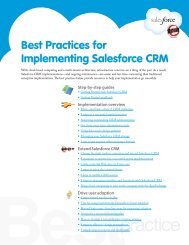- Page 1: Version 30.0: Spring ’14Database.
- Page 4 and 5: Table of ContentsrenameMetadata()..
- Page 7 and 8: GETTING STARTEDChapter 1Understandi
- Page 9 and 10: Understanding Metadata APIDevelopme
- Page 11 and 12: Chapter 2Quick StartThe easiest way
- Page 13 and 14: Quick StartStep 3: Walk Through the
- Page 15: Quick StartStep 3: Walk Through the
- Page 18 and 19: Quick StartStep 3: Walk Through the
- Page 20 and 21: USING METADATA APIChapter 3Deployin
- Page 24 and 25: Deploying and Retrieving MetadataSa
- Page 26 and 27: Deploying and Retrieving MetadataMa
- Page 28 and 29: CRUD-Based Metadata DevelopmentNote
- Page 30 and 31: Chapter 5Error HandlingMetadata API
- Page 32 and 33: File-Based Callsdeploy()2. If the c
- Page 34 and 35: File-Based Callsdeploy()NamerunAllT
- Page 36 and 37: File-Based Callsdeploy()if (!deploy
- Page 38 and 39: File-Based CallscancelDeploy()1. Is
- Page 40 and 41: File-Based Callsretrieve()}}// and
- Page 42 and 43: File-Based Callsretrieve()private v
- Page 44 and 45: File-Based Callsretrieve()}} catch
- Page 46 and 47: File-Based CallscheckRetrieveStatus
- Page 48 and 49: Chapter 7CRUD-Based CallsUse the fo
- Page 50 and 51: CRUD-Based Callsupdate()1. Determin
- Page 52 and 53: CRUD-Based CallscreateMetadata()}//
- Page 54 and 55: CRUD-Based CallsreadMetadata()nf.se
- Page 56 and 57: CRUD-Based CallsupdateMetadata()upd
- Page 58 and 59: CRUD-Based CallsdeleteMetadata()Ver
- Page 60 and 61: CRUD-Based CallsrenameMetadata()}if
- Page 62 and 63: Utility CallsdescribeMetadata()desc
- Page 64 and 65: Utility CallsListMetadataQueryRespo
- Page 66 and 67: Result ObjectsAsyncResultNameTypeDe
- Page 68 and 69: Result ObjectsDeployResultNamedonei
- Page 70 and 71: Result ObjectsDeployResultNamestate
- Page 72 and 73:
Result ObjectsDeployResultRunTestsR
- Page 74 and 75:
Result ObjectsDescribeMetadataResul
- Page 76 and 77:
Result ObjectsRetrieveResultEach Re
- Page 78 and 79:
Result ObjectsErrorErrorRepresents
- Page 80 and 81:
Metadata TypesMetadata TypeMetadata
- Page 82 and 83:
Metadata TypesUnsupported Metadata
- Page 84 and 85:
Metadata TypesApexTriggerApexTrigge
- Page 86 and 87:
Metadata TypesAppMenuField NameFiel
- Page 88 and 89:
Metadata TypesCallCenterVersionCall
- Page 90 and 91:
Metadata TypesCustomObjectVersionCu
- Page 92 and 93:
Metadata TypesCustomObjectField Nam
- Page 94 and 95:
Metadata TypesCustomFieldField Name
- Page 96 and 97:
Metadata TypesCustomFieldField Name
- Page 98 and 99:
Metadata TypesCustomFieldssnThe fir
- Page 100 and 101:
Metadata TypesNamedFilter....See Al
- Page 102 and 103:
Metadata TypesPicklist (Including D
- Page 104 and 105:
Metadata TypesPicklist (Including D
- Page 106 and 107:
Metadata TypesPicklist (Including D
- Page 108 and 109:
Metadata TypesSharingRecalculationr
- Page 110 and 111:
Metadata TypesWeblinkDeclarative Me
- Page 112 and 113:
Metadata TypesWeblinkField Nameopen
- Page 114 and 115:
Metadata TypesMetadata Field TypesF
- Page 116 and 117:
Metadata TypesExternalDataSourceFie
- Page 118 and 119:
Metadata TypesInstalledPackageInsta
- Page 120 and 121:
Metadata TypesLayoutField Namerelat
- Page 122 and 123:
Metadata TypesLayoutField Nameunitw
- Page 124 and 125:
Metadata TypesLayoutField Namelayou
- Page 126 and 127:
Metadata TypesLayoutField Namerelat
- Page 128 and 129:
EditOwnerIdEditCurrencyIsoCodeTwoCo
- Page 130 and 131:
Metadata TypesMetadatafeedItemTypeC
- Page 132 and 133:
Metadata TypesPermissionSetNamename
- Page 134 and 135:
Metadata TypesPermissionSetFieldedi
- Page 136 and 137:
Metadata TypesProfileCustomTabJob_R
- Page 138 and 139:
Metadata TypesProfileField Nameapex
- Page 140 and 141:
Metadata TypesProfileField Nameallo
- Page 142 and 143:
Metadata TypesProfile}// Employees
- Page 144 and 145:
Metadata TypesQueueFieldsThis metad
- Page 146 and 147:
Metadata TypesQuickActionField Name
- Page 148 and 149:
Metadata TypesRemoteSiteSettingDecl
- Page 150 and 151:
Metadata TypesSamlSsoConfigFieldsFi
- Page 152 and 153:
Metadata TypesSettingsField Namesam
- Page 154 and 155:
Metadata TypesActivitiesSettingsFil
- Page 156 and 157:
Metadata TypesActivitiesSettingsFie
- Page 158 and 159:
Metadata TypesBusinessHoursSettings
- Page 160 and 161:
Metadata TypesBusinessHoursSettings
- Page 163 and 164:
Metadata TypesMobileSettingsFielden
- Page 165 and 166:
Metadata TypesSecuritySettingsField
- Page 167 and 168:
Metadata TypesSecuritySettingsField
- Page 169 and 170:
Metadata TypesSharingRulesFieldsFie
- Page 171 and 172:
Metadata TypesBaseSharingRuleequals
- Page 173 and 174:
Metadata TypesCriteriaBasedSharingR
- Page 175 and 176:
Metadata TypesSiteDotComFieldField
- Page 177 and 178:
Metadata TypesWorkflowDeclarative M
- Page 179 and 180:
Metadata TypesWorkflowField Nametar
- Page 181 and 182:
Metadata TypesWorkflowField Namecri
- Page 183 and 184:
Metadata TypesWorkflowadmin@acme.co
- Page 185 and 186:
GlossaryA |B |C |D |E |F |G |H |I |
- Page 187 and 188:
GlossaryEEnterprise WSDLA strongly-
- Page 189 and 190:
GlossaryMany-to-Many RelationshipA
- Page 191 and 192:
GlossaryRelationship QueryIn a SOQL
- Page 193 and 194:
GlossaryVValidation RuleWA rule tha
- Page 195 and 196:
IndexIndexAAccount Team Roles 16Acc
- Page 197:
IndexWSC 6WSDL integration 5-6ZZip
















